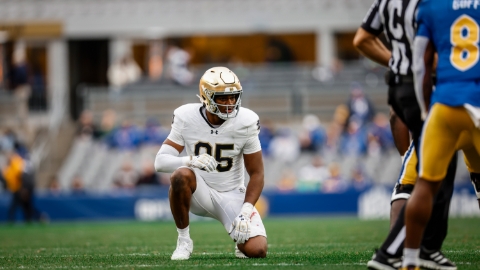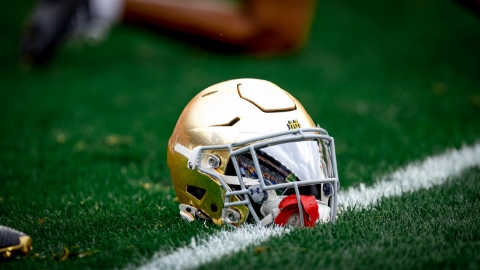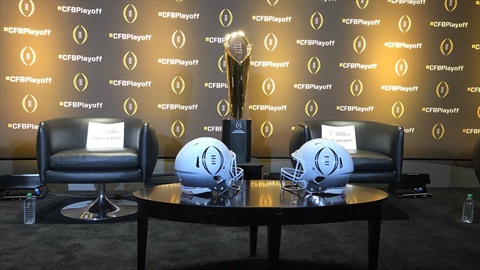
Before Marcus Freeman coached a game at Notre Dame, he made a major impact in recruiting. Less than a few weeks on the job as defensive coordinator, he helped convince current Notre Dame defensive tackle Tyson Ford to commit to the Irish when he was leaning to Oklahoma. He continued making that kind of impact by landing commitments from six more blue-chip (4 and 5-star) defenders before the team started practicing in the fall.
Freeman has maintained that approach in upgrading Notre Dame’s roster since then. He spoke to the Make Defense Great Again podcast in 2021 and though he was talking specifically as a coordinator at that time, he pretty much laid the blueprint for how he planned to build a program.
For him, it’s about Jimmy’s and Joe’s.
“That’s my philosophy. Different coordinators, different coaches, have different philosophies...and that’s just mine. We’re going to recruit really well. I’m going to try and outwork you in recruiting, so that over time, we step on the field and have an advantage. That’s a belief of mine. We’re going to out-recruit the guys we are going against.
“Let’s out-recruit them, one, because to me, you can have a distinct advantage when you step on the field. But two, and I want to say this the right way, I’m not trying to beat you in a chess match. That’s not my philosophy. I believe that we have to be multiple, but we’re going to do what we do in terms of our kids are not going to be confused. They are going to get good at the things we ask them to do.”
Freeman and his staff have made a significant impact in terms of improving the talent. The evidence with that is in the number of blue-chip recruits they have signed or have committed in the last two and half classes.
Blue-chip ratio (BCR) is a term that 247Sports Bud Elliott came up with when he worked at SB Nation. It’s typically cited as the percentage of blue-chip recruits a program has signed over a four-year period to assess whether or not a team can win a national championship (more on that in a bit), but it’s also a good way to look at how a team has recruited in general.
How well has Freeman recruited since he joined the staff? Pretty darn good. The BCR for his two and half classes is 79%.
Brian Kelly’s final team had a BCR of 55%.
24% more blue-chips is a big deal. People can point to not landing enough top-50 or top-100 recruits, but the sheer volume of that many more 4-stars on a roster makes a program better from off-season workouts to practices to depth on Saturdays in the fall. Freeman and the staff still have to develop and retain them, but anyone who says that the new staff hasn’t significantly upgraded recruiting isn’t basing that on actual data.
If the 2024 class wrapped up today, the BCR for Notre Dame next year with the 2021-2024 classes would be 70%. I’m bringing this up because of a question ISD poster xavierirish33 asked for Power Hour this week that was submitted after we had already recorded. He asked:
What do you think about blue chip percentage as a predictor of on field success? Do you put a lot of faith in it?
I have been following recruiting for a long time now and I'm really starting to believe in it.
I think BCR is a great way to see how much raw talent a program is accumulating and as Elliott points out annually, it’s a great way to determine who actually has a shot at winning a national championship.
It’s not infallible, though. Teams who recruit better than everyone else win more than teams that don’t, but it doesn’t mean that some teams who have recruited well are close to being a College Football Playoff contender.
I looked at all of the teams who had a BCR of 60% or more in the CFP era and took out the 2020 season because of how it was structured. With that in mind, there were 64 teams who qualified and 39 of them won 10 or more games (61%).
It’s no surprise that teams are more likely to be successful that are recruiting at a high level, but it also means that 39% of those teams didn’t win 10 games.
Notre Dame was at 60%+ in four seasons and only won 10 games in one of those four (2015). Two of those seasons they won nine games, 2014 and 2022, so it’s not like they weren’t close. There were reasons those teams underachieved, though. In 2014 that team fell apart down the stretch after that close loss to Florida State, but their biggest issue was that they didn’t have depth at defensive tackle and were decimated at the position. The 2022 team lost their starting quarterback in the second game, had a new head coach, and that BCR was boosted significantly by the freshmen class they brought in. They weren’t nearly as loaded in the older recruiting classes.
The other one was 2016. That might make people want to throw BCR out the window because it would seem crazy that a team who had recruited at that level over four years would end up 4-8. Notre Dame fans are well aware of all of the issues that team had at certain positions (injuries and suspensions at defensive back, a dearth of talented upperclassmen on the defensive line) and with the coaching staff.
The culture of the program was bad too. There is no doubt about that. There’s a reason that Kelly had to do a full-on reboot after that season.
The ‘16 team is included with 11 others out of the 64 who had losing seasons. Five of those seasons were with new head coaches (Charlie Strong, Willie Taggart, Billy Napier, Steve Sarkisian, and Brent Venables) and there are plenty of times where a bad culture was a driver in these teams severely underachieving.
Signing more blue-chips doesn’t guarantee success for every program. It just increases the odds of it happening.
Retaining the players is just as important as well because Oklahoma was at 71% last year, but 27 of the blue-chips who made up a big chunk of that 71% are no longer on the roster. Texas A&M was at 70% last year largely because of that number one class they signed. They already lost seven blue-chip transfers from that class and that number of transfers is over 20 combined with the two classes before it.
From those same classes, Notre Dame has lost eight blue-chips and one of those is Joey Tanona who had to medically retire before he ever practiced at Notre Dame.
Having more talent matters. Retaining, developing, and nurturing that talent in a good culture matters just as much when it comes to winning. Having more talent matters the most when it comes to winning at the highest level and Freeman has been taking the proper steps towards that.
2. Notre Dame has played 14 games where they had a lower BCR than their opponent since 2017. I think a lot of people would be surprised that they finished 7-7 in those games.
It’s misleading to only look at the overall record because three of those wins came against USC and they’ve only recently stopped being a mess. Two more of those wins were when the teams were extremely close in BCR. Clemson had only an edge by a percentage point last year (63-62) and Michigan was by four in 2018 (61-57). Even that big 2020 victory against Clemson was fairly close (63-56) and the key was them missing Trevor Lawrence that day. When they had Lawrence, they won the rematch.
There are three games that stand out and where everyone, including Notre Dame’s coaching staff, knew they were woefully overmatched when it came to talent.
Ohio State was 80-62 last season and the game plan for Notre Dame reflected that. Alabama was 83-56 in 2020 and the game plan reflected that too. Georgia in 2019 was 79-54 and go back and look at the game plan for the Irish that day. They only ran the ball 12 times. Two of those were perimeter runs with Lawrence Keys and another was a designed run with Ian Book.
Again, I’m going to point back to how much closer things were in 2017 for Notre Dame and Georgia. It was 63-56 that day. In 2019 they went up 16% and Notre Dame dropped two.
Primarily because of the last two classes, the Irish are going to be at 67.4% for 2023. They are moving in the right direction, but it’s 52.3% for third and fourth year players and 82.2% for first and second year players. That’s a scenario that favors Notre Dame for the next couple of years, but not this fall.
3. 2016 Clemson is the only team to win a championship in the CFP era where they were under 60% BCR (52%). For many reasons, that Clemson team is an extreme outlier.
Ohio State (68), Alabama (77), Alabama (80), Clemson (61), LSU (64), Alabama (83), Georgia (80), and Georgia (77) recruited much better. I don’t think that the 2016 Clemson team would have won any of those other seasons. It was just the right time with the right quarterback.
USC wants to be that outlier this year. They definitely have the right quarterback. They are over the 50% threshold (58.7%) in BCR and the transfer portal has helped fill a lot of holes on their roster.
They signed only 62 high school players over the last four years, though. They are only at 75 scholarships currently and they would need Caleb Williams to essentially pitch a perfect game to have a shot against teams who have significantly more talent, especially up front.
They only have four offensive or defensive linemen that they signed who were blue-chip recruits. They added four more in the transfer portal, but eight is the exact same number they had last year as well and that wasn’t good enough to win the Pac-12. It's a different ball game going up against CFP level teams.
Michigan has been getting a lot of hype as a national championship contender as well this off-season, but their BCR is 51.6%. A lot of that is veteran talent, but they play a style of game that matches up poorly with a team like Georgia. Michigan could bully Ohio State, but not a Georgia run defense that has dominated teams for four years.
We may see a team win a national championship with less than a 60% BCR some time in the next decade, but this year’s USC and Michigan teams would need all of the stars to align perfectly for it to be them.
4. In the last five full college football seasons (not including the disjointed 2020 season), there have been eight defenses who have finished in the DF+ top-10 (combined FEI and SP+ rating) three or more times: Alabama (5), Georgia (5), Clemson (4), Penn State (4), Wisconsin (3), Iowa (3), and Auburn (3).
I don’t think anyone will be surprised to see those first three programs or to see Wisconsin or Iowa given how those teams have been competitive mostly because of their defenses. I’m not sure if anyone would be too surprised by Penn State either because they did win 11 games in three of those four years and they weren’t doing it with Sean Clifford lighting up the scoreboard.
Auburn is the most surprising to me because it’s easy to forget the kind of talent they are able to recruit there. They had three straight top-10 defenses from 2017-2019 and the strength of those teams was on the defensive line. They had double digit blue-chips in their three-deep in each of those seasons (10, 12, and 10). They also were anchored by Derrick Brown (1st round) and Marlon Davidson (2nd round).
Go to their depth chart today and they have four transfers set to start for them. Six of their top-12 are transfers. They have four blue-chips they recruited in that group, but three of them are true freshmen. It’s going to be a massive rebuilding job for Hugh Freeze to get that defense back to where they were.
Notre Dame has had three top-15 defenses in the last five years (2018, 2019, and 2021), but hasn’t had a top-10 defense since 2012. Their path to get there is similar to the one Auburn used before they went back to being bad Auburn again. The Irish need to keep building the talent up front and then they can make that leap on defense.
They’ll have 13 former blue-chip recruits in their defensive line room this fall and seven of them will be in year one or year two at Notre Dame.
5. It’s truly incredible that Jimbo Fisher has been able to get not one, but two monster contracts out of Texas A&M. No one has done less with more than him when it comes to talent on his roster.
He had two losing seasons with over a 60% BCR, never won more than 10 games when he had that kind of talent, and averaged 7.6 wins a season during those years.
On paper it looks like they will be pretty close to the upper tier this season (72.4%), but as I mentioned previously, a number of those players who were part of that percentage have already left the program.
We can’t judge Marcus Freeman based on one season and he’s in the process of reshaping the roster that he inherited, but he has put himself in a position to win because they also have managed the roster well overall during his first year and a bit as head coach. Out of the 82 scholarship players on the 2023 Fighting Irish, 56 of them were blue-chips (68.3% up from 63% last year). That’s after losing players like Tyler Buchner, Prince Kollie, and Lorenzo Styles to the transfer portal.
Whether it’s culture, roster management, bad coaching hires, lack of development, or a host of other reasons, Fisher has done an incredibly poor job with the material he has had on his roster. To be able to sign all that talent and not win with it is putting him in the category of the worst head coaches with a national championship on their resume.
6. The one thing that I don’t think gets discussed enough about Notre Dame is the culture that existed before Freeman was named head coach. He was part of that in his one year as defensive coordinator, but it was years of building it.
If not for that culture, Notre Dame’s season could have spiraled after an 0-2 and then 3-3 start. Maintaining that has to be a priority while the staff goes about retooling the roster. That’s a lot easier to do with someone like Freeman because even though many of the older players aren’t technically “his guys” that he brought in, they are pretty much all his guys because that’s his personality as a coach.
The roster isn’t all the way Freeman’s yet in terms of the players he recruited. He also couldn’t flip the whole thing like some of these other coaches can with the transfer portal. Even without that, 49 of the players on scholarship signed with Freeman as high school recruits or college transfers. Six of those players are in year three to six.
33 players in year three to six were signed by Brian Kelly. It’s a safe bet that close to half of those players (give or take) will not be on the roster next season. In 2024 it should be around 75-80% of the roster with Freeman recruits/transfers.
Woo, that’s a lot of big picture recruiting/roster stuff in 6 Thoughts this week, but it’s May and there’s already so much focus on what players Notre Dame is landing or not landing in recruiting. That will only get turned up as the calendar hits July and many of the official visitors from June start making commitments.
I think Notre Dame has done a nice job with the roster so far during the Freeman era. Closing out this 2024 class the right way can really put the Irish on a path towards the best group of Jimmy’s and Joe’s Notre Dame has had in many years.
Notre Dame Fighting Irish 20'' x 36'' Etched Wood Flag




